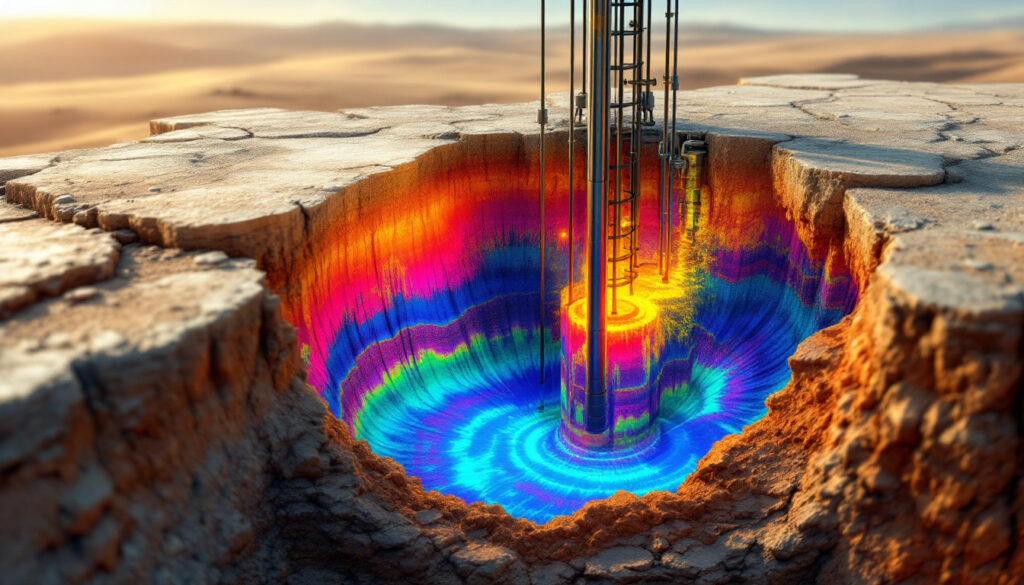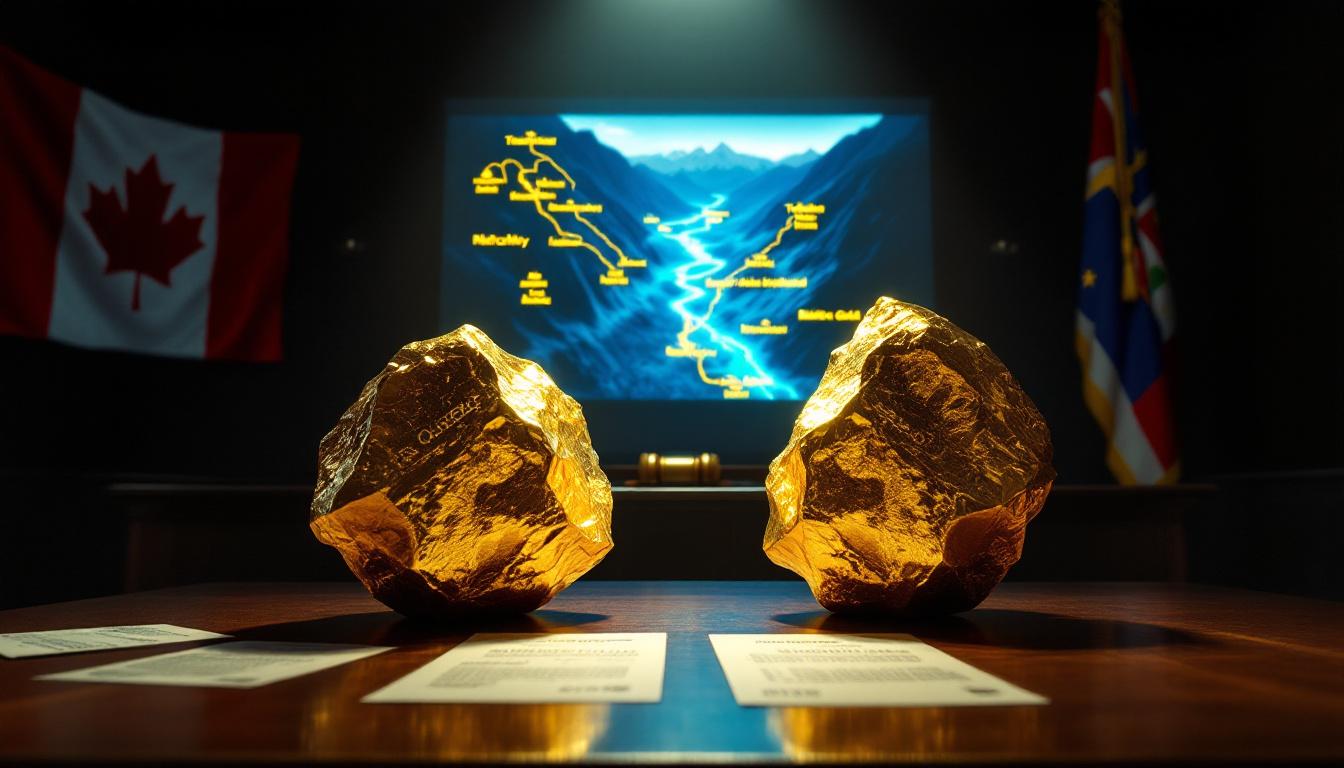Downhole Geophysics in Mineral Exploration: Advanced Methods and Applications
Downhole geophysics has revolutionized mineral exploration by providing direct access to subsurface geological information that surface methods simply cannot match. This specialized discipline involves measuring rock properties in situ, delivering high-resolution data that significantly enhances exploration success rates while reducing costs. Understanding mining drilling results becomes much more effective when combined with these advanced geophysical techniques.
What is Downhole Geophysics?
Downhole geophysics involves measuring the physical properties of rocks along a subsurface drill hole to gather critical data about the surrounding geological environment. Unlike surface geophysical surveys, downhole methods provide direct measurements of rock properties in situ, offering higher resolution data and more accurate interpretations.
Surveys measure rock properties within a few centimeters of the drill hole, offering precision unattainable via surface methods, while probe technology can extend exploration reach up to hundreds of meters beyond the drill hole itself, dramatically expanding the value of each hole drilled.
How Downhole Geophysical Surveys Work
Specialized probes attached to wire cables are lowered into completed drill holes, carefully calibrated to detect specific rock properties. These sophisticated instruments combine multiple sensors into single units for efficiency.
Each probe typically contains both an energy source/transmitter and recording sensors, working in tandem to measure responsive signals from surrounding rock formations.
Data is transmitted to the surface in real-time via cable or wireless technology, allowing geophysicists to monitor quality and make adjustments during the survey process.
Multiple probes can be connected in series to collect different types of geophysical data simultaneously, maximizing the information gathered during a single downhole run.
Surveys require coordination between geophysical contractors and drilling teams to ensure optimal hole conditions and timing.
When to Use Downhole Geophysics
Early exploration stages, particularly in "greenfield" areas with limited geological information, benefit tremendously from downhole data to establish baseline rock properties.
After initial drilling to maximize the value of expensive drill holes, downhole surveys extract additional value from each meter drilled.
Before drill holes collapse or are closed, as timing is critical—surveys should ideally be conducted within 72 hours of drilling completion to prevent hole collapse risks.
When surface geophysical surveys provide ambiguous results requiring verification, downhole methods offer direct measurements that can resolve uncertainties.
"Down-hole geophysical surveys are incredibly valuable because they directly measure properties that are usually only implied by complex modelling of data collected at surface." – Kylie Williams, Geology for Investors
Why is Downhole Geophysics Important for Mineral Exploration?
Downhole geophysical methods provide critical advantages that surface methods cannot match, delivering precise measurements that translate directly to exploration success. According to industry statistics, these surveys can reduce unnecessary drilling by 20–30% through improved targeting, representing significant cost savings in exploration budgets. Furthermore, these techniques provide essential geological insights that are invaluable for investment decision-making.
Extending the Value of Drill Programs
Provides information about rocks up to several hundred meters beyond the drill hole, effectively multiplying the exploration coverage of each hole drilled.
Can identify ore zones narrowly missed by drilling, potentially detecting mineralization within 150–300 meters of existing drill holes.
Improves the reliability of 3D geophysical models across the entire claim area by providing calibration points for surface geophysical data.
Maximizes return on investment from expensive drilling programs by extracting additional value from each meter drilled.
Enhancing Geological Understanding
Delivers precise measurements of physical rock properties in their natural state, undisturbed by weathering or sampling biases.
Helps correlate rock types between drill holes, establishing stratigraphic relationships across the exploration area.
Identifies alteration zones associated with mineralization, often providing vector information pointing toward ore deposits.
Provides data to refine geological models and target future drilling with significantly greater precision.
Detecting Hidden Mineralization
Can locate conductive ore bodies like massive sulfides near but not intersected by drilling, as demonstrated in a Western Australian nickel sulfide discovery located 200 meters from the drill hole using EM surveys.
Identifies dense mineral zones that may indicate economic deposits through gravity and density measurements.
Maps magnetic anomalies associated with certain deposit types, particularly those containing pyrrhotite concentrations above 5% in alteration zones.
Reveals resistivity patterns typical of alteration halos around ore deposits, providing indirect evidence of nearby mineralization.
What Physical Properties Can Be Measured?
Downhole geophysical tools measure a wide range of physical properties, each providing distinctive information about potential mineralization. These precise measurements help explorers identify and characterize mineral deposits with remarkable accuracy. Such information is particularly valuable when evaluating economic viability from mining feasibility studies.
Density Measurements
Uses a radioactive source that emits gamma rays, typically cesium-137 or cobalt-60, to measure electron density in surrounding rocks.
Dense materials contain more electrons and reflect more gamma rays, allowing gamma-ray backscatter to quantify electron density for ore minerals with ±0.1 g/cm³ accuracy.
Effectively identifies zones containing dense minerals like:
- Metal-sulfides (galena, bornite, chalcopyrite, pentlandite)
- Oxides (chromite)
- Alteration minerals (pyrite, magnetite, hematite, pyrrhotite)
Measures density of materials immediately intersected by the drill hole, providing direct calibration data for surface gravity surveys.
Gravity Surveys
Detects variations in the Earth's gravitational field related to rock density, identifying potential ore bodies through subtle gravitational anomalies.
Can identify high-density formations within several hundred meters of the drill hole, extending exploration reach beyond the physical limits of drilling.
Particularly effective for detecting:
- Massive sulfide deposits
- Chromite ore bodies
- Iron ore deposits
- Some stockwork mineralization
- Barite (barium sulfate) deposits
Multiple surveys in different drill holes may be needed to pinpoint anomaly locations through triangulation of gravity signatures.
Magnetic Susceptibility and Field Measurements
Measures how rocks respond to the Earth's magnetic field, quantifying their ability to become magnetized when exposed to an external field.
Reflects the presence of magnetic minerals, primarily magnetite but also minerals like pyrrhotite in sufficient concentrations.
Effective for mapping alteration zones containing:
- Iron oxides (hematite, maghemite, limonite)
- Magnetic sulfides (pyrrhotite)
Magnetic field surveys penetrate further from the drill hole but provide indirect estimates of magnetic mineral content based on field distortions.
Can detect both induced and remanent magnetization, helping distinguish between different types of magnetic signatures.
How Are Electrical Properties Measured Downhole?
Electrical properties provide critical insights into mineralization potential, particularly for sulfide-rich deposits. These measurements detect both connected and disseminated mineralization through their distinctive electrical signatures. Modern digital transformation in mining has greatly enhanced the precision and interpretation of these measurement techniques.
Direct Current Induced Polarization (DCIP)
Injects alternating current directly into rocks (typically two seconds on, two seconds off), creating a controlled electrical field in the subsurface.
Measures voltage response using receivers at the surface or downhole, capturing both immediate and delayed electrical responses.
Records both conductivity/resistivity (current on) and chargeability (current off), providing complementary datasets that help characterize mineralization.
Particularly useful for disseminated sulfide deposits like porphyry copper systems, with DCIP surveys measuring chargeability up to 100 mV/V for disseminated sulfides.
Conductivity Measurements
Identifies rocks and minerals that allow electrical current to flow, detecting massive to semi-massive mineralization with distinctive conductive properties.
Particularly effective for detecting:
- Veins, stringers, or massive sulfide bodies of copper or nickel ore
- Connected sulfide minerals acting like electrical wires
- Other conductive minerals (magnetite, specular hematite, carbon, graphite)
Critical for targeting VMS and nickel sulfide deposits where conductive minerals form interconnected networks.
Resistivity Surveys
Measures how poorly rocks conduct electricity (inverse of conductivity), providing contrast between different rock types and alteration styles.
Identifies zones of highly resistive minerals like quartz, with resistivity contrasts differentiating quartz veins (10,000+ Ω·m) from sulfides (<100 Ω·m).
Particularly useful for mapping:
- Silicic alteration in porphyry deposit cores
- Quartz veins associated with gold mineralization
- Alteration halos around ore bodies
Chargeability Analysis
Measures a rock's ability to hold electrical charge (like a battery), reflecting the presence of disseminated but disconnected sulfide grains.
Highest responses come from rocks with common but disconnected sulfide minerals, typically indicating low-grade but potentially economic mineralization.
Ideal for targeting:
- Copper porphyry deposits
- Low-grade nickel deposits
- Disseminated sulfide mineralization
According to Abitibi Geophysics, "Chargeability peaks correlate with low-grade nickel deposits (>1% sulfide content)," providing a quantitative threshold for exploration targeting.
What is Downhole Electromagnetic (EM) Surveying?
Downhole EM is perhaps the most powerful tool for detecting massive sulfide mineralization near but not intersected by drilling. This method has been responsible for numerous discoveries of ore bodies that would otherwise have been missed. The technique has proven especially valuable in copper mines exploration where sulfide conductors are typical.
Transmits an electric field into rocks, which is converted to a magnetic field by conductive materials, creating a secondary EM field that can be measured.
Measures the strength of the induced magnetic field, with conductors producing distinctive time-domain decay responses that help characterize their size and composition.
Particularly effective for locating strong conductors like:
- Nickel sulfide bodies
- Chrome deposits
- Massive sulfide ore bodies
Can detect conductive bodies situated at a distance from the drill hole, with detection ranges of 150-300 meters for strong conductors.
Helps discriminate between different types of conductors based on their decay characteristics, distinguishing between ore minerals and non-economic conductors like graphite.
What Other Downhole Survey Tools Are Available?
Beyond the primary geophysical methods, several specialized tools provide additional data that enhance interpretation and targeting. These tools address specific exploration needs and provide complementary datasets.
Imaging Technologies
Downhole cameras for still images and video of in-place rock formations, providing visual confirmation of structures and mineralization.
Optical and acoustic televiewers for high-resolution borehole wall imaging, generating continuous unwrapped images of the drill hole wall.
Structural analysis tools for measuring fractures and bedding planes, providing orientation data critical for understanding mineralization controls.
Directional Tools
Precisely measure depth and orientation of drill holes, ensuring accurate spatial positioning of all downhole data.
Critical for accurate 3D modeling and targeting, particularly in complex structural environments.
Often included in the string of probes sent downhole, providing essential spatial context for all other measurements.
Radiometric Measurements
Detect natural radioactivity in rocks, measuring emissions from radioactive isotopes.
Measure levels of uranium (U), thorium (Th), and potassium (K), which often correlate with certain alteration styles.
Useful for identifying certain types of alteration associated with uranium deposits or potassic alteration in porphyry systems.
Can help with stratigraphic correlation between drill holes, identifying distinctive radiometric markers across a project area.
How to Implement Downhole Geophysics in Your Exploration Program
Effective implementation requires careful planning, coordination with drilling operations, and integration with other exploration data. The investment typically represents 5–15% of drilling program costs but can substantially improve exploration success rates.
Planning Considerations
Budget for downhole surveys during drill program planning, ensuring sufficient funds are allocated for comprehensive data collection.
Coordinate with drilling contractors to ensure hole stability, including appropriate drilling fluids and casing if necessary.
Select appropriate survey methods based on target deposit type, focusing on methods most likely to detect the mineralization style sought.
Consider the timing of surveys to prevent hole collapse, ideally conducting surveys within 72 hours of drilling completion.
Data Integration and Interpretation
Combine downhole geophysical data with:
- Core logging information
- Geochemical analysis results
- Surface geophysical survey data
Use integrated datasets to refine 3D geological models, with integration through specialized software like Leapfrog delivering results 50% faster than manual interpretation.
Identify correlations between physical properties and mineralization, establishing predictive relationships for future targeting.
Target future drilling based on comprehensive data analysis, prioritizing anomalies with multiple supporting indicators.
Cost-Benefit Analysis
Weigh the additional cost against potential value added to the project, typically representing 5-15% of drilling costs but potentially reducing unnecessary drilling by 20-30%.
Consider the expense of missing nearby ore bodies that could be detected, potentially worth millions in undiscovered resources.
Evaluate the cost of additional drilling versus downhole surveys to extend exploration reach, with surveys often providing better value per dollar spent.
Factor in the improved targeting efficiency for future drill programs, which can significantly improve discovery rates and accelerate project development.
FAQs About Downhole Geophysics
What is the difference between surface and downhole geophysical surveys?
Surface geophysical surveys measure physical properties from above ground, providing broad coverage but lower resolution. Downhole surveys measure properties directly within the subsurface environment, offering higher resolution data about specific rock units and potential mineralization near the drill hole.
How deep can downhole geophysical surveys reach?
The depth of investigation depends on the method used. While density and magnetic susceptibility measurements are limited to rocks immediately adjacent to the drill hole, methods like downhole EM can detect conductive bodies several hundred meters away from the hole. The actual detection range varies with the strength of the conductor and background conditions.
Which downhole method is best for targeting massive sulfide deposits?
Downhole EM surveys are particularly effective for targeting massive sulfide deposits due to their high conductivity. These surveys can detect conductive sulfide bodies that may have been missed by drilling, making them essential tools in the exploration for VMS, nickel sulfide, and similar deposit types. For disseminated sulfides, IP methods typically provide better results.
How do downhole geophysical surveys improve drilling efficiency?
By providing information about rock properties beyond the drill hole, downhole surveys help explorers better target subsequent drilling. This improves the efficiency of exploration programs by increasing the likelihood of intersecting mineralization and reducing the number of holes required to define a deposit. Many companies report drilling efficiency improvements of 20-30% after implementing comprehensive downhole survey programs.
When in the exploration process should downhole geophysics be implemented?
Downhole geophysics is most valuable during early to middle stages of exploration when geological understanding is still developing. It's particularly useful after initial drill testing has identified promising areas but before detailed resource definition drilling begins. However, surveys should be conducted within 72 hours of drilling completion to prevent hole collapse risks.
Expert Insight: Implementing downhole geophysical surveys early in exploration programs can significantly enhance geological understanding and improve targeting efficiency, potentially saving millions in unnecessary drilling costs while increasing discovery potential.
Conclusion: Maximizing Exploration Success with Downhole Geophysics
Downhole geophysical surveys represent a critical tool in modern mineral exploration, providing valuable insights that cannot be obtained through other methods. By directly measuring the physical properties of rocks in their natural state, these surveys help explorers identify potential mineralization, map geological structures, and target future drilling more effectively.
The integration of downhole geophysical data with other exploration information creates a comprehensive understanding of subsurface geology, significantly improving the chances of exploration success. While adding to the cost of drilling programs, the additional value gained through enhanced targeting and reduced drilling requirements typically far outweighs the investment.
As exploration increasingly focuses on deeper targets and more subtle mineralization styles, downhole geophysics in mineral exploration will continue to play an essential role in the discovery and delineation of new mineral resources. Companies that systematically implement these methods typically report higher discovery rates and more efficient resource definition, translating to better returns on exploration investment.
Ready to Stay Ahead of the Next Major Mineral Discovery?
Discovery Alert's proprietary Discovery IQ model instantly notifies investors about significant ASX mineral discoveries, turning complex downhole geophysics data into actionable investment opportunities. Understand why major discoveries lead to exceptional returns by exploring our dedicated discoveries page and begin your 30-day free trial today to position yourself ahead of the market.




